Podcast: Play in new window | Download
Subscribe: Apple Podcasts | RSS
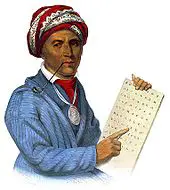 “My great-great grandmother was a Cherokee princess.” This is a claim often heard in the United States when people seek to have a link to a romantic Native American past. Out of the 500+ tribes in the United States, it seems the Cherokees are the ones often used to justify a distant Indian lineage. Indeed, a sitting US senator used unverified claims of Cherokee ancestry, and thus “minority” status, to get into Harvard and propel her academic career forward. A presidential candidate even made fun of her ruse by calling her “Pocahontas.” The distant Cherokee lineage is so often cited by many people in the United States because the Cherokees played an important role in the early history of the US and for various reasons, they traveled to different parts of North America as the young United States grew and pushed them out of their lands. Also, in the early part of American history, many Cherokees intermarried with Europeans across a wide geographical area. Many people have heard of the Trail of Tears and the forced relocations of southeastern native tribes to Arkansas and Oklahoma. Very few people know of the Cherokees’ migration to Mexico and the impact they had on their new country. This is their story.
“My great-great grandmother was a Cherokee princess.” This is a claim often heard in the United States when people seek to have a link to a romantic Native American past. Out of the 500+ tribes in the United States, it seems the Cherokees are the ones often used to justify a distant Indian lineage. Indeed, a sitting US senator used unverified claims of Cherokee ancestry, and thus “minority” status, to get into Harvard and propel her academic career forward. A presidential candidate even made fun of her ruse by calling her “Pocahontas.” The distant Cherokee lineage is so often cited by many people in the United States because the Cherokees played an important role in the early history of the US and for various reasons, they traveled to different parts of North America as the young United States grew and pushed them out of their lands. Also, in the early part of American history, many Cherokees intermarried with Europeans across a wide geographical area. Many people have heard of the Trail of Tears and the forced relocations of southeastern native tribes to Arkansas and Oklahoma. Very few people know of the Cherokees’ migration to Mexico and the impact they had on their new country. This is their story.
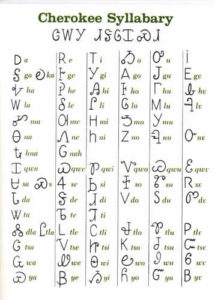 At the time of European contact, the Cherokee homeland consisted of the lands comprising parts of modern-day North and South Carolina, Tennessee, Georgia and Alabama. The Cherokee language is part of the Iroquoian Language Group, which supports theories of anthropologists that the Cherokee originally migrated from the Great Lakes around 3,500 years ago. This would also support some Cherokee legends that tell of a great wandering from the shores of a large sea and the eventual settling down in the southern Appalachians. As a footnote, in 1809 the Cherokee language was the first native language outside of Mesoamerica to have a written language, as a man named Sequoyah developed what would be called the Cherokee Syllabary. As a leader, Sequoyah will play a small role in the story of the Mexican band of the Cherokees.
At the time of European contact, the Cherokee homeland consisted of the lands comprising parts of modern-day North and South Carolina, Tennessee, Georgia and Alabama. The Cherokee language is part of the Iroquoian Language Group, which supports theories of anthropologists that the Cherokee originally migrated from the Great Lakes around 3,500 years ago. This would also support some Cherokee legends that tell of a great wandering from the shores of a large sea and the eventual settling down in the southern Appalachians. As a footnote, in 1809 the Cherokee language was the first native language outside of Mesoamerica to have a written language, as a man named Sequoyah developed what would be called the Cherokee Syllabary. As a leader, Sequoyah will play a small role in the story of the Mexican band of the Cherokees.
By the time Sequoyah had invented the Cherokee writing system, the tribe had already felt pressure from the young United States. Many Cherokees began to migrate out of their homeland voluntarily, to escape the growing American presence. In 1806, a small band of Cherokees founded a village on the shores of the Red River in Spanish-controlled Texas and later this same group petitioned the Spanish authorities at Nacogdoches to have a permanent settlement there. The Spanish granted them their request. Between 1812 and 1822 Cherokee immigration to Texas increased and by 1822 there were 800 Cherokees living in Texas. By then, Texas was a province of Mexico. The new central government in Mexico City denied the Cherokees their petition for land grants while at the same time encouraging more Indians from the southeastern United States to settle in Texas, to offset the increasing numbers of Anglo-American settlers coming to the province. In the War of Texas Independence of 1835 to 1836, the 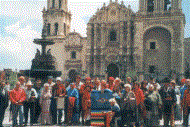 Cherokees tried to remain neutral. As president of Texas, Sam Houston sought an alliance with the Cherokee and drew up a treaty with them guaranteeing their lands and certain rights. The treaty was never ratified by the Texas legislature and the Cherokees felt slighted. Some saw the new Republic of Texas as just an extension of the same United States that they or their immediate ancestors had fled. Many felt more loyalty to Mexico, which, although did not grant them land, did let them live in peace. In 1838 a number of Tejanos, the Spanish-Mexican inhabitants of Texas, joined with some militant Cherokees to rebel against the new government of the Republic of Texas. This uprising was called the Córdova Rebellion after the former mayor of Nacogdoches, Vicente Córdova. Rumors spread throughout Texas that the Tejano and Indian uprisings were being supported by General Santa Anna of Mexico who wanted to take back Texas for Mexico. Under increasing scrutiny, the Cherokees in Texas felt the need to migrate again. The days of the Cherokee in Texas ended with the Cherokee War of 1839. In two battles the natives were defeated, relinquished their 600,000 acres of land and were formally driven out of Texas. Most went north to what is now Oklahoma, others decided to go south.
Cherokees tried to remain neutral. As president of Texas, Sam Houston sought an alliance with the Cherokee and drew up a treaty with them guaranteeing their lands and certain rights. The treaty was never ratified by the Texas legislature and the Cherokees felt slighted. Some saw the new Republic of Texas as just an extension of the same United States that they or their immediate ancestors had fled. Many felt more loyalty to Mexico, which, although did not grant them land, did let them live in peace. In 1838 a number of Tejanos, the Spanish-Mexican inhabitants of Texas, joined with some militant Cherokees to rebel against the new government of the Republic of Texas. This uprising was called the Córdova Rebellion after the former mayor of Nacogdoches, Vicente Córdova. Rumors spread throughout Texas that the Tejano and Indian uprisings were being supported by General Santa Anna of Mexico who wanted to take back Texas for Mexico. Under increasing scrutiny, the Cherokees in Texas felt the need to migrate again. The days of the Cherokee in Texas ended with the Cherokee War of 1839. In two battles the natives were defeated, relinquished their 600,000 acres of land and were formally driven out of Texas. Most went north to what is now Oklahoma, others decided to go south.
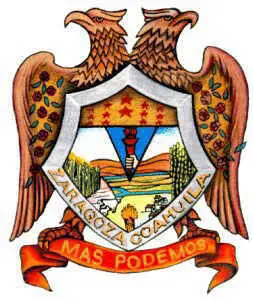 As mentioned before, the Cherokees started moving out of their homeland in what is now the southeastern United States when the European population increased. The first group of Cherokees to cross the Rio Grande into the modern country of Mexico did so in 1720 and settled in what is now the state of Coahuila. Between the 1720s and the time of the Texas Revolution – a period of over 100 years – the population of Cherokees south of the Rio Grande only increased slightly and many of the original migrants had intermarried and assimilated into the local indigenous and non-indigenous communities. After the Texas Revolution northern Mexico saw a new influx of Cherokees seeking a political asylum called amparo from the Mexican government, which was granted by the governor of Coahuila. Hundreds of people resettled in the Mexican states of Coahuila, Tamaulipas, Nuevo Leon and Chihuahua with the largest group settling in the town of San Fernando, Coahuila, near the modern-day city of Zaragoza. Here, in remote northern Mexico, these refugees were allowed to set up their own limited tribal governments and kept pretty much to themselves.
As mentioned before, the Cherokees started moving out of their homeland in what is now the southeastern United States when the European population increased. The first group of Cherokees to cross the Rio Grande into the modern country of Mexico did so in 1720 and settled in what is now the state of Coahuila. Between the 1720s and the time of the Texas Revolution – a period of over 100 years – the population of Cherokees south of the Rio Grande only increased slightly and many of the original migrants had intermarried and assimilated into the local indigenous and non-indigenous communities. After the Texas Revolution northern Mexico saw a new influx of Cherokees seeking a political asylum called amparo from the Mexican government, which was granted by the governor of Coahuila. Hundreds of people resettled in the Mexican states of Coahuila, Tamaulipas, Nuevo Leon and Chihuahua with the largest group settling in the town of San Fernando, Coahuila, near the modern-day city of Zaragoza. Here, in remote northern Mexico, these refugees were allowed to set up their own limited tribal governments and kept pretty much to themselves.
The isolation of the Cherokee communities in northern Mexico was short-lived, however. Three years after the last mass migration of 1839, the refugees received an important visitor from across the border. It was Sequoyah, the originator of the Cherokee written language. He traveled to northern Mexico to try to encourage the Mexican Cherokees to unite with the rest of the tribe that had been dispersed to Oklahoma and Arkansas. The government of the Republic of Texas had regarded Sequoyah as an Indian agitator and a threat to the new republic. It had heard about Sequoyah’s activities in Mexico and sent an armed contingent across the Rio Grande to arrest Sequoyah and take him back to Texas where his future status would be determined. Although over 70 years old and suffering from a lung infection at the time, Sequoyah escaped in the middle of the night while he and his captors camped near the Rio Grande, and returned to the  Cherokee community outside of Zaragoza. Three local and powerful hacienda families – named Platinos, Rodriguez and Salinas – gave Sequoyah shelter and hid him from the Texans who scoured the rugged terrain of Coahuila looking for him. Exhausted and ill, Sequoyah died in a cave in Coahuila just a few weeks after his escape. According to some sources Sequoyah had believed that Mexico was the ancient homeland of the Cherokees and the source of all the tribe’s knowledge and wisdom. As this is not based on any sort of verifiable history, Sequoyah’s statement may very well have just been based in part on the man’s deep affinity and good feelings for the people he met while in Mexico.
Cherokee community outside of Zaragoza. Three local and powerful hacienda families – named Platinos, Rodriguez and Salinas – gave Sequoyah shelter and hid him from the Texans who scoured the rugged terrain of Coahuila looking for him. Exhausted and ill, Sequoyah died in a cave in Coahuila just a few weeks after his escape. According to some sources Sequoyah had believed that Mexico was the ancient homeland of the Cherokees and the source of all the tribe’s knowledge and wisdom. As this is not based on any sort of verifiable history, Sequoyah’s statement may very well have just been based in part on the man’s deep affinity and good feelings for the people he met while in Mexico.
Very little attention would have been paid to the Cherokee refugees in Mexico and their descendants if not for two things that have happened relatively recently: A rise in indigenous consciousness in Mexico and an increase in people claiming Indian ancestry in the United States. In the 1990s the Zapatista rebellions in the southern Mexican states brought to the forefront of the Mexican national consciousness the neglected rights of the indigenous. In 1996 the Zapatistas and the federal government of Mexico signed the San Andrés Accords on Indigenous Rights and Culture which recognized certain cultural and political rights of indigenous people throughout Mexico. On August 4, 2001, President Vicente Fox signed into law the amendments to the Mexican constitution affording these new political and cultural protections for Mexico’s native populations. A few weeks after the amendments were 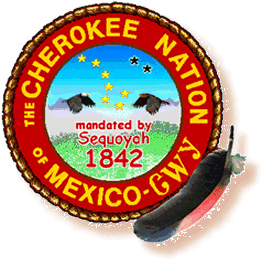 added to the constitution, the Cherokees of northern Mexico petitioned the governor of Coahuila for a formal recognition of “the strong continuing bond that exists between the Cherokees and the Mexicans.” Governor Enrique Martinez granted the recognition without hesitation. Some have alleged that the move to recognize the Mexican band of Cherokees was a backdoor way of getting federal recognition from the United States government for people claiming Cherokee ancestry living in Texas. The person behind the Mexican recognition of the tribe’s descendants in Coahuila is a man named Charles L. Rogers, a resident of Brownsville, Texas. Rogers, who also calls himself “Chief Jahtlohi Rogers” is head of a group calling itself “Cherokee Nation of Sequoyah of Mexico, Texas, and U.S.A., Reservation and Church.” This is a tax-exempt “religion-related, spiritual-development” group and is formally known as “The Cherokee Nation of Mexico Texas and Coahuila Reservation and Church.” While one cannot assume a person’s or a group’s real intentions, some have alleged that by creating an umbrella organization to include Cherokees on both sides of the border, this group is piggybacking off of the Mexican state of Coahuila’s recognition of that band of Cherokees to get US federal recognition of people claiming Cherokee heritage in Texas. With federal recognition would come a whole slew of benefits for “tribal members.” The
added to the constitution, the Cherokees of northern Mexico petitioned the governor of Coahuila for a formal recognition of “the strong continuing bond that exists between the Cherokees and the Mexicans.” Governor Enrique Martinez granted the recognition without hesitation. Some have alleged that the move to recognize the Mexican band of Cherokees was a backdoor way of getting federal recognition from the United States government for people claiming Cherokee ancestry living in Texas. The person behind the Mexican recognition of the tribe’s descendants in Coahuila is a man named Charles L. Rogers, a resident of Brownsville, Texas. Rogers, who also calls himself “Chief Jahtlohi Rogers” is head of a group calling itself “Cherokee Nation of Sequoyah of Mexico, Texas, and U.S.A., Reservation and Church.” This is a tax-exempt “religion-related, spiritual-development” group and is formally known as “The Cherokee Nation of Mexico Texas and Coahuila Reservation and Church.” While one cannot assume a person’s or a group’s real intentions, some have alleged that by creating an umbrella organization to include Cherokees on both sides of the border, this group is piggybacking off of the Mexican state of Coahuila’s recognition of that band of Cherokees to get US federal recognition of people claiming Cherokee heritage in Texas. With federal recognition would come a whole slew of benefits for “tribal members.” The 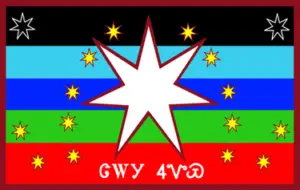 Eastern Band of Cherokees located in North Carolina is one of the three federally recognized Cherokee tribal groups in the United States. In 2011, the Eastern Band established the Cherokee Identity Protection Committee and in October of that year published a list of over 200 groups across the US and Canada claiming to be Cherokee. This “fraud list” includes everything from a group of mostly African-American people located in the Bronx, New York, to a small encampment of people in Oregon claiming Cherokee ancestry and the right to be recognized by the government. “Chief” Jahtlohi Rogers’ “The Cherokee Nation of Mexico Texas and Coahuila Reservation and Church” is not on the list and neither is the band of Cherokees in northern Mexico. The list however, is not exhaustive and is constantly being updated and revised. On the Mexican side of the border, the Cherokee language is not recognized by the federal government of Mexico as an official indigenous language, and that is probably because the descendants of the Cherokee refugees have lost their language in the 170 years of living in Mexico. No matter what politically-motivated people may say, it is unknown just how many people in northern Mexico are descended from the Cherokees as they no longer form a cohesive cultural community. We will probably never know the impact of these refugees on northern Mexico or on the country as a whole. As a new indigenous consciousness continues to develop throughout Mexico, the fate of the
Eastern Band of Cherokees located in North Carolina is one of the three federally recognized Cherokee tribal groups in the United States. In 2011, the Eastern Band established the Cherokee Identity Protection Committee and in October of that year published a list of over 200 groups across the US and Canada claiming to be Cherokee. This “fraud list” includes everything from a group of mostly African-American people located in the Bronx, New York, to a small encampment of people in Oregon claiming Cherokee ancestry and the right to be recognized by the government. “Chief” Jahtlohi Rogers’ “The Cherokee Nation of Mexico Texas and Coahuila Reservation and Church” is not on the list and neither is the band of Cherokees in northern Mexico. The list however, is not exhaustive and is constantly being updated and revised. On the Mexican side of the border, the Cherokee language is not recognized by the federal government of Mexico as an official indigenous language, and that is probably because the descendants of the Cherokee refugees have lost their language in the 170 years of living in Mexico. No matter what politically-motivated people may say, it is unknown just how many people in northern Mexico are descended from the Cherokees as they no longer form a cohesive cultural community. We will probably never know the impact of these refugees on northern Mexico or on the country as a whole. As a new indigenous consciousness continues to develop throughout Mexico, the fate of the  Mexican Cherokee remains unknown.
Mexican Cherokee remains unknown.
REFERENCES:
Various online sources.

23 thoughts on “The Forgotten Cherokee Nation of Mexico”
Hi there, can anyone give me information about the cherokees that were known to of settled near lake chapala jalisco
Hi Kerry, I have never heard of that group. That sounds like a whole other podcast!
hi i belong to the Cherokee nation of mexico its a internet group only who don’t do anything 🙁 I’M TRYING TO FIND A TALK TO OTHER who belong to it and if we can take a bad/fake thing a make it areal/ great thing my email is swlewis09@gmail.com if anyone want to talk about them
Hi Steven. If you want to reach out to more people, leave a comment in the comments section of my YouTube “slideshow” of this podcast. Here is the link: https://youtu.be/y7ufF2CxOn0 Thanks for stopping by.
I just found out that I am native american 31% from the Southern Texas and Northern Mexico . I don”t know what tribe , I just started looking into all this . my mothers father was said to be Cherokee an Choctaw and Irish . trying to learn all i can and anything anyone knows would help
Hi Margaret Ann, There were also a small group of Choctaws who crossed the Rio Grande to Mexico. You might want to cross-post your comments on my YouTube channel to make contact with others who can help you. I am glad this podcast served you on your journey. Keep going!
It seems I do somewhat 🙂
According to anthropological records recorded in the US Congressional Serial Set by James Mooney, in 1860, the main body of Cherokee, who had previously departed in 1721, sent a runner to Tahlequah with a letter stating that they had been at Lake Chapala, and that they were migrating southward. The Keetoowah Society has never accepted the USA as their original homeland. Their are several Blogtalk Radio programs on this subject.. Go to http://www.blogtalkradio.com/search?q=Jahtlohi
can anyone give me the email address of the Cherokee Nation of Mexico
YOU MAY DIRECT QUESTIONS TO NIGHTHAWKWEBWORKS@YAHOO.COM
I need help!! My grandma was born in Baja Mexico and she was cherokee she married my grandpa and left Mexico to start a family in California but I don’t know her parents and I don’t know how to go about this
You might want to try to track down the Cherokee Nation of Mexico. I believe they have a web site and you might be able to get some family history information from them.
Cherokee Nation of Mexico does not have any genealogy resources. We don’t require any for registration, just as our ancient ancestors did not.
Search online for her baptism record in Baja. The record will not only list her parents, but quite possibly her grandparents. Her godparents will be listed, and are another clue, and godparents were frequently family.
My father was born Ricardo Rodriguez Noyola in Saltillo Coahuila, Mex. in 1901. I called Hall of Records in Saltillo and they said my father was not register because the Indian didn’t register their children only baptized them. I do have my fathers baptism papers. My father and his mother (Julia Rodriguez) moved to Lawton, OK. His last name was change to Nollola and on the census of 1030 it was Richard Odalo. He married my mother in Anadarco,Ok. They lived in the reservation. My first three brother were born in Cyril, Caddo County, Ok. I don’t know what tribe we belong to. My mom said Cherokee. How can I find out. My brother took an ancestry DNA test , we are 50 percent Native. Thank you.
I think you might have to go down to Saltillo and do some investigating of your own. You can go to the church of the baptism and see if they have records of your father’s parents and/or grandparent. Those records might have important clues. Good luck with your research!
Most likely the records are online. You can search for free at Family Search.
My family on my mother’s side are descendants of Cherokee who ended up in North Alabama just before the Trail of Tears. I assume they were fleeing capture to be resettled on reservations in the West. Some of the family actually ended up on a Creek reservation some how in the 1870s. My grandmother old stories of how they were told to hide their native American heritage then by 1990 people were quite happy to claim that heritage. Just because the senator called “Poncahonas” was proved to have a small amount of native American DNA, it does not mean she did not have family who suffered. My several great grandfather was killed here in North Alabama in the 1870s and his killers were not punished because he was believed to be Cherokee. I’ve never tried to benefit off my native roots but I do understand how the senator can feel a connection to the Iroqua. She is old enough that she heard stories from grandparents that influenced her.
Hi Myra. Thanks for sharing your comments.
Would you stop lying about Elizabeth Warren? Seriously, isn’t Trump’s racist name calling enough? https://www.snopes.com/fact-check/elizabeth-warren-wealthy-native-american/
She’s also apologized privately to members of the Cherokee nation. Yes, LOTS of White folks claim Cherokee ancestry. Yes, Warren did it on ‘scant evidence’ (but not zero evidence), but she didn’t use this claim to advance her career.
Otherwise, I enjoyed reading your post/ podcasts.
Not only is it disrespectful but it’s pretty stupid of you to come to my site and accuse me of being a liar. What I said about the “senator” was not a lie at all. She didn’t put down “Native American” in the ethnicity category when filing out her college forms because she was a registered member of a tribe or because she had any cultural connection to any Native American group. Forget about a legitimate blood quantum. So, why did she do it? Any idiot knows in the merit-less Affirmative Action World, the way to get ahead is to claim minority/victim status. Warren did just that, plain as day. And I guess it worked: This “woman of the people” is now a multimillionaire and bathes in privilege. Who knows where she would have been without this lie. She probably would have been stuck in a community college somewhere and would now be working as a court stenographer or secretary in an obscure office. It sounds like the only liar here is you, and you are lying to yourself. So sad.
I know how you can tell the difference. Let me explain
ABRAHAM’S FAMILY
I want to show you here how DNA or race doesn’t tell us who we are, but how we act tells us who we are. Let me give you a better understanding of what was happening at this time. Adam was cast from the Garden and sent forth to till the earth. We find the tribes of Adam here in Palestine/Israel, Syria, and Jericho tending the first farms. They were teaching surrounding tribes how to domesticate animals and seeds for crops, to hunt, to make fire, … As the populations grew and the people settled to an agrarian based society and became more localized and less nomadic hunter gatherers wandering from place to place, we became more dependent on these tribes. The people of Adam’s tribe were becoming slaves to the growing populations and were growing tired of working the fields, so they started calling for leaders that could take care of the gathering of food to free them up to do other things. Whatever it may have been. They decided that tilling the fields wasn’t for them. These leaders were chosen from the Scythians. These Scythians were Iranian Nomads. Iran means Aryan, they were Caucasian. They were Nomads that believed there was no one above them except their creator. Their territory stretched all the way from Persia, todays Iran, all the way North into the Caucasus Mountains and the Ukraine. The Scythians are Isaac, Abraham’s 2nd son. The Slavs looked to them to lead them, and these Scythian leaders became the 1st Kings in the Levant. I’m not saying they were the 1st, Kings; I’m speaking to the 1st rulers in particular to Palestine/Israel, Syria, and Jericho. The difference between a King and a Sovereign is subjects. A King needs subjects to rule over, while a Sovereign only wishes to rule themselves. The Scythians misunderstood their Sovereignty and thought it was special only to them. The people of Adam’s tribe that gave up their Sovereignty for a ruler became the Slavs. These Slavs and others followed the Scythian Kings into Europe and Russia. I always ask people if they know what the term “Slav” means. Of course, they always say yes, it means “Slave”. That’s not exactly true, which is why I asked in the 1st place. “Slav” came to mean “Slave”. If you look up the etymology of “Slav” it means “Glory”. The Slavs were the Sovereigns from Adams tribe who could have ruled themselves but became slaves when they ask these leaders to do for them what they could have done for themselves. They decided they didn’t want to till the earth anymore and left Adam’s tribe. This is Ishmael, Abraham’s 1st son born from an Egyptian maid. They are the mixed breed. Ishmaels tribe were given a King and became “Slaves” to other men.
The tribes of Abraham are Sovereigns’ +, they have to remain Sovereign+ practice the Laws of the Torah, or they lose their status as a Jew, like these Slavs did when they followed the Monarchies from the Levant up into Europe. In the Mid-East before Christianity and Islam was the Sabean faith. This was the faith started by Abraham, that there was no one above you except your creator. Sabean is one of the 7 Churches John was told to write to:
SABEAN
THE GREEK WORD EPHESUS MEANS “PALE”
4000 to 5000 B.C.
REVEALER ABRAHAM
John is told to write to the angel of the church of Ephesus. Ephesus is the name of one of the towns in Turkey where John had been teaching the Christian Faith. Most realize that the ruins are no longer significant as a church, however the name is significant, as the meaning of the word is ‘Pale’. Since this is a Christian book, many would like to attribute ‘Pale’ to a Christian congregation, however it also relates to one of the religions of the world. This is the attribute that describes the Sabean Religion, believed to have existed since 5000 B.C. It is the oldest religion of the seven. The people who continue to refer to themselves as Sabeans, in Iraq and Iran, believe that Abraham was a founder of their religion, and that John the Baptist was a Sabean.
Indeed, among the Sabeans, Abraham is considered to be the founder of their faith. Amongst the great prophets was His Holiness Abraham who, being an iconoclast and a herald of the oneness of God, was banished by the people from his native land. (‘Abdu’l-Bahá, Bahá’í Scriptures, p. 388)
Christianity and Islam were born from it. In Islam they believe that Jesus is the most important Prophet of all the Prophets. Christians are told to use Jesus as their example. The story of Jesus is the story of a Sovereign, he believed there was no one above him except his creator.
Isaac, the Scythian Kings begin their rule in the Levant and spread into Europe and Russia. Not all the Scythians were Kings. They had a choice, and the choice they made was made by their actions. They either followed the Kings into Europe and Russia and became subjects of a crown or they remained as nomads that lived outside the city. These Scythian nomads were the Sarmatians. The Sarmatians were a large confederation of ancient Eastern Iranian equestrian nomadic peoples of classical antiquity who dominated the Pontic steppe from about the 3rd century BCE to the 4th century CE. Originating in the central parts of the Eurasian Steppe, the Sarmatians were part of the wider Scythian cultures. They started migrating westward around the fourth and third centuries BC, coming to dominate the closely related Scythians by 200 BC. At their greatest reported extent, around 100 BC, these tribes ranged from the Vistula River to the mouth of the Danube and eastward to the Volga, bordering the shores of the Black and Caspian seas as well as the Caucasus to the south.
In the first century AD, the Sarmatians began encroaching upon the Roman Empire in alliance with Germanic tribes. In the third century AD, their dominance of the Pontic Steppe was broken by the Germanic Goths. With the Hunnic invasions of the fourth century, many Sarmatians joined the Goths and other Germanic tribes in the settlement of the Western Roman Empire. Since large parts of today’s Russia, specifically the land between the Ural Mountains and the Don River, were controlled in the fifth century BC by the Sarmatians, the Volga–Don and Ural steppes sometimes are called “Sarmatian Motherland.” The Sarmatians in the Bosporan Kingdom assimilated into the Greek civilization, while others were absorbed by the Alans and the Goths. Other Sarmatians were assimilated and absorbed by the Early Slavs. A people related to the Sarmatians, known as the Alans, survived in the North Caucasus into the Early Middle Ages, ultimately giving rise to the modern Ossetic ethnic group.
These Sarmatians mated with the Mongoloids and became the Tartar Turks. These Sarmatians, Mongoloids and Tartar Turks make up the Christians that started the Christian Church. These Tartar Turks are Jacob, Abraham’s grandson. The Church isn’t a building you go to and pray. The Church is each and every individual SOVEREIGN. The SOVEREIGNS, Sarmatians, created the Church building as a way to protect their Sovereignty from the Scythian Kings, or anyone else for that matter. If the Slavs wished for a ruler, that was fine as far as a Sovereign went, as long as they didn’t try and force those rulers on them. So, if a Sovereign was being harassed by govt and was threatening them, the Sovereign could go to the Church and ask for Sanctuary. If you hadn’t committed a crime, meaning you had hurt someone, the Church wouldn’t let the state intervene until jurisdiction had been established. The only way for the state to get jurisdiction would be if you had hurt someone. If you had hurt someone the Church would release you back to the state for punishment. If you had been accused of a statute the Church would tell the Monarchy to go kick rocks and you would be released.They were our protection from govt run amuck! This is why we aren’t supposed to follow anyone except our creator. Kings were men and men can be easily corrupted as we have all seen firsthand for ourselves. The Church was there to make sure Govt. authority wasn’t forced on us. This is why they had to corrupt the Church and the way we see religion. All the faiths are teaching us Sovereignty and they couldn’t have that.
Abraham is called by God to leave the house of his father Tehra and settle in the land of Canaan, which God now promises to Abraham and his progeny. This promise is subsequently inherited by Isaac, Abraham’s son by his wife Sarah, while Isaac’s half-brother Ishmael is also promised that he will be the founder of a great nation. Abraham purchases a tomb (the Cave of the Patriarchs) at Hebron to be Sarah’s grave, thus establishing his right to the land; and, in the second generation, his heir Isaac is married to a woman from his own kin, thus ruling the Canaanites out of any inheritance. Abraham later marries Keturah and has six more sons; but, on his death, when he is buried beside Sarah, it is Isaac who receives “all Abraham’s goods” while the other sons receive only “gifts”.
They seem to have taken your site down and I am in the middle of writing a book about all this stuff. I want to use the things you had posted on that site in the book. I would appreciate it if maybe someone there could email me the info from it. If you would like me to explain further, I certainly could. PeaceY
I was trying to keep my answer short, but this is what I have before that in the book. I should have added it. It explains a little further back. PeaceY
The Book of Genesis says that Adam was cast from the Garden of Eden and was told to till the earth. The Culture Heroes were part of what the Chinese call the 3 Sovereigns and 5 emperors. Around 5000BC the Chinese were being taught by who they called Culture Heroes. A culture hero is a mythological hero specific to some group (cultural, ethnic, religious, etc.) who changes the world through invention or discovery. Although many culture heroes help with the creation of the world, most culture heroes are important because of their effect on the world after creation. A typical culture hero might be credited as the discoverer of fire, agriculture, songs, tradition, law, or religion, and is usually the most important legendary figure of a people.
To go back to this time, I only have myth (oral stories) to go by. What I did was ask where farming, seed and animal domestication, tools (to TILL the earth) and where they originated? This led me to Syria, Jericho, and Palestine/Israel. Finds of large quantities of seeds and a grinding stone at the Epipalaeolithic site of Ohalo II in Palestine/Israel, dating to around 19,400 BP (Before Present years, or “years before present”, is a time scale used mainly in archaeology, geology and other scientific disciplines to specify when events occurred relative to the origin of practical radiocarbon dating in the 1950s.) has shown some of the earliest evidence for advanced planning of plants for food consumption and suggests that humans at Ohalo II processed the grain before consumption. Tell Aswad in Syria 30 miles from Damascus is the oldest site of agriculture, with domesticated emmer wheat dated to 10,800 BP. Soon after came hulled, two-row barley – found domesticated earliest at Jericho in the Jordan valley and at Iraq ed-Dubb in Jordan.
From about 30,000 BC human existence became more refined until social and economic forms of agriculture appeared around 10,000 to 7,500BC. This took the form of hoe gardening done mainly by women and led to matriarchal based societies. From around 6,000BC the horse was tamed, and sheep, goats and cattle were domesticated so that by 5,000 there existed a mixed culture based on animal breeding and hoe gardening. The great plough revolution starting about 4,500 was complete by 4,000BC. This enabled the first city civilizations to arise, the introduction of writing and shortly after a developing “social technology.”
The Culture Heroes in Chinese mythology are known as the 3 Sovereigns. The 3 Sovereigns represent Syria, Jericho, and Palestine/Israel. These are the tribes of Adam teaching everyone how to grow food and domesticate animals and seeds for crops… There is a way to tell as I will show you right now. The 3 Sovereigns believed there was no one above them except their creator, that’s the definition of a Sovereign. They were forced from their homeland, Syria, Jericho, and Palestine/Israel, as the Monarchies came to power in the Levant. The Sovereigns could only live where they were Sovereign and only had God ruling over them, so when the ruling Monarchies came to power in the Levant, it forced the Sovereigns out for their belief that there was only 1 God, 1 Law, that ruled them. Adam’s tribe is Abraham. That’s his story. Abraham was an iconoclast that believed in the oneness of God who was cast from his homeland for his beliefs and forced to live in foreign lands. This is the beginning of Judaism. Abraham was the 1st Jew.